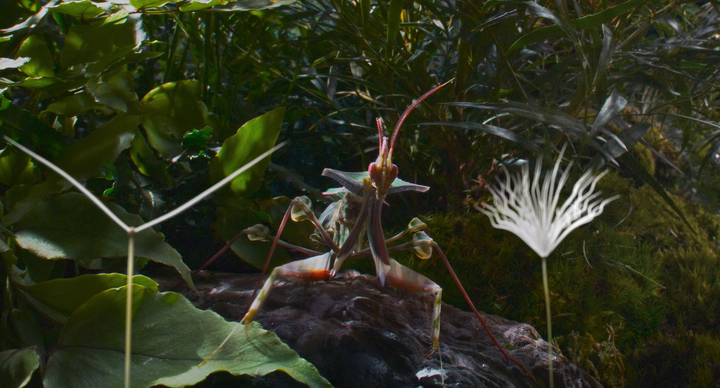Director: Momoko Seto
Writers: Mariette Désert, Alain Layrac, Momoko Seto
Synopsis: Rescued from Earth’s nuclear annihilation, four friends crash-land on an unknown planet and courageously set out to locate a new home capable of sustaining their species.
Momoko Seto has spent the great majority of her film career crafting animated shorts and pieces about nature. Her films are somewhat unconventional, but they are interesting because she experiments with animation and live-action footage to create parables about the world surrounding us and why we must protect it at all costs. It is related to her studies at Le Fresnoy, the National Studio for Contemporary Arts, and her work in the CNRS (National Scientific Research Center), where she combines her love for science and admiration for cinema in her documentaries. The films that most reflect this intertwining are the ones in her Planet scenes, which began in 2009 with Planet A and continues with her latest work, and feature-length debut, Dandelion’s Odyssey (Planètes, screening at the 2025 Cannes Film Festival sidebar, Semaine de la critique).
Dandelion’s Odyssey is a very intriguing picture conceptually, like most of Seto’s decades-long work. She plays with the concept of stop-motion animation and the silent film tropes, particularly slapstick comedy, to keep the story fresh and interesting for viewers of all ages as Seto extends her narrative from ten minutes to seventy-two. There are moments where you feel you are watching real animals wandering around the animated plains, and others where it feels like a stop-motion picture from a big studio. This intertwining between documentary and animation kept me hooked on the film for half of its runtime. But these intriguing, mold-breaking techniques in its production can’t take you far enough if you have a weak structure and narrative. This odyssey is quite a drag, feeling like a chore as it runs its course.
A bombastic score, similar to the ones heard in the MCU’s most suspenseful moments, introduces the film, as the stars in the galaxy unite to form a dandelion. The vast void of space is now embalmed in the flowers’ pappus, which dissipate upon uneasy blow, turning the screen entirely black, once again into a void, hinting at a forthcoming cataclysm. Each freckle of the pappus falls onto the Earth’s soil. It plants itself into the ground and is reborn as a full-grown dandelion. The flower sits upon the plains, abiding by the rule of nature, alongside other insects and animals that wander the terrain. But sooner rather than later, paradise becomes hell for every living creature. A series of nuclear explosions bolstering the land in sheer flames, with only two dandelions managing to escape–the select survivors of the planet once called Earth.
They float into space, reaching the moon, as the dandelions bask upon a planet becoming a great ball of fire. It is a striking image that calls back to disaster and end-of-the-world films, although it has a more visually stimulating and dread-inducing atmosphere than most pictures in the subgenre could concoct. With no sense of direction or a place to call home, the dandelions float in the void of space, entering a black hole which transports them into a new galaxy, with mystical creatures all over. The rest of the film follows these dandelions going from one planet to another in search of a place to call home and begin their species lineage anew. On these planets, some beautiful scenery and landscapes immediately grab your attention.
There’s a beauty that feels palpable and ultra-realistic, as if these flowers and animals were right there with you. Seto uses varied animation styles to create distinct textures and moods for each planet, whether an ice-covered land or a dangerous tundra. The images don’t have much depth, as the film’s message about protecting the Earth gets across early in the expedition. The one that struck me the most was seeing a planet bursting into flames, but that is because of the existential crisis that sometimes talking about the nothingness of space causes. Outside of that one, the great majority didn’t move me. I did feel intrigued. My continued engagement stemmed mainly from fascination with the film’s technical ingenuity, especially in how Seto came up with the specificity of these planets. Nevertheless, concerning the story being told, my interest fades vastly.
The use and potency of the imagery aside, the main reason why Dandelion’s Odyssey drags on is that the concept is better suited for a short rather than a feature-length film. Seto has created many successful shorts in the past few decades, even winning a handful of awards for some of them. She wants to utilize the same formula that worked in the short film format in a lengthier, broader canvas, front and back. And as she extends this story and formula from ten minutes to seventy-plus, there’s a feeling that halfway through, it repeats the same beats over a different landscape. It becomes quite boring; the film is not dull per se, as the technical elements arouse genuine interest, but it is definitely repetitive and tedious. I wish Seto would venture into other territories and continue to play with the medium. She has a unique and innovative vision as a filmmaker; the only thing keeping her from achieving her top potential is the scope of her concepts.







